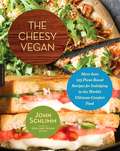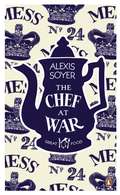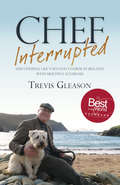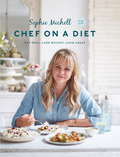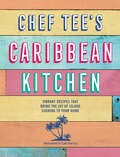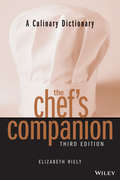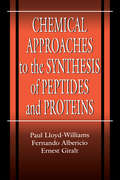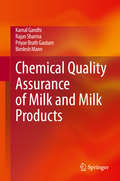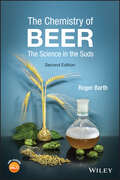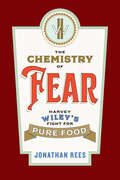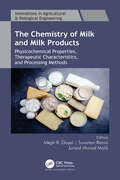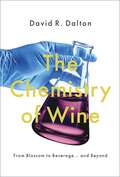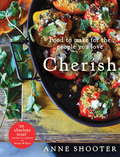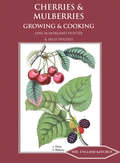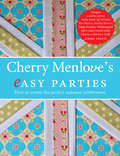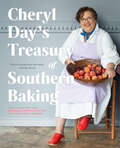- Table View
- List View
The Cheesy Vegan: More Than 125 Plant-Based Recipes for Indulging in the World's Ultimate Comfort Food
by John SchlimmLong regarded as the missing link in the plant-based world, vegan cheese has come home to Main Street! With more than 125 recipes for every cheesy craving, John Schlimm has you covered from breakfast to lunch to a hearty dinner with family and friends. From easy recipes for everyday cheeses (including Cheddar, Swiss, mozzarella) to ultimate comfort food like Mac 'n' Cheese, Cafe Broccoli & Parmesan Quiche, Triple Your Pleasure Fondue, and the Cheesecake Extravaganza, you can include in all your cheesy favorites ... with none of the dairy.
The Cheesy Vegan: More Than 125 Plant-Based Recipes for Indulging in the World's Ultimate Comfort Food
by John SchlimmLong regarded as the missing link in the plant-based world, vegan cheese has come home to Main Street! With more than 125 recipes for every cheesy craving, John Schlimm has you covered from breakfast to lunch to a hearty dinner with family and friends. From easy recipes for everyday cheeses (including Cheddar, Swiss, mozzarella) to ultimate comfort food like Mac 'n' Cheese, Cafe Broccoli & Parmesan Quiche, Triple Your Pleasure Fondue, and the Cheesecake Extravaganza, you can include in all your cheesy favorites . . . with none of the dairy.
The Chef at War
by Alexis SoyerThe flamboyant Frenchman Alexis Soyer was the most renowned chef in Victorian England. This is his colourful account of his time at the front in the Crimean War, where he joined British troops in order to improve the quality of the food they were eating. Divulging the secrets of preparing stew for 1000 soldiers, sharing sweetmeats with a Turkish Pacha, and teaching a Highland regiment to cook with his pioneering gas-fuelled 'field stove' that would be used by armies up until the Second World War, Soyer gives a vividly enjoyable lesson in making a little go a long way.
Chef Interrupted: Discovering Life's Second Course in Ireland with Multiple Sclerosis
by Trevis GleasonIn April 2001, Trevis Gleason was a chef on the rise. Then one day he suffered a stroke-like episode and was diagnosed with multiple sclerosis. He lost everything – his job, his marriage, even his perceived persona. Surveying the ruins of his former life, he saw an opportunity to fulfill a long-postponed dream: he put life in Seattle on hold and moved to west Kerry. Renting a cottage in ‘The Town’, and tapping into a profound passion for food, he learned his life, loves and even dreams weren’t lost – just waiting to be rediscovered. Trevis surmounts physical setbacks and cultural differences with self-effacing wit, serving up life’s lessons and his favourite recipes one tasty chapter after another. This is a story not of survival, but of living life to the full. Trevis’s inspirational humour in the face of his changed life is sure to have you coming back for seconds.
Chef on a Diet: Loving Your Body and Your Food
by Sophie MichellThey say you should never trust a skinny chef - but what if that skinny chef held the secret to losing weight without compromising on foodie pleasure? In her new book, executive chef Sophie Michell reveals the recipes she herself has used to lose weight despite spending all day, every day, surrounded by food. Sophie has developed this diet with an emphasis on flavour, so you'll never feel like you're missing out, even as you drop the pounds. The recipes have been carefully formulated to provide you with essential proteins and nutrients, and will leave you full of energy, with your taste buds satisfied and your body slimmer. With everything from smoothies and juices to brunches, packed lunches and impressive yet achievable mains, this diet allows you to really embrace your love of food. Enjoy a breakfast of Avocado and Chipotle Frittata, a dinner of Crisp Duck Wings with Miso Glaze and Kimchi Salad, and an array of tempting sweet dishes such as Hazelnut and Dark Chocolate Cake. The recipes are so tasty you'll want to keep cooking them long after you reach your goal weight, helping you to maintain it - as Sophie says, a successful diet is 'a life choice, not something you endure to lose the pounds. ' With the focus on flavour and enjoyment rather than calorie counting, it's time to diet like a chef.
Chef Tee's Caribbean Kitchen
by Chef TeeBring the joy of Caribbean cooking to your kitchen and discover 80 varied and exciting recipes, from street food grills to one-pot stews, salads and rum-based cocktails. Caribbean cuisine offers a world of flavour from Jamaica to Trinidad and Tobago and everything in between, all the islands have their own unique dishes and cooking styles. In this sunshine filled book you’ll find recipes for mouth-watering hot sauces, spice rubs, fragrant marinades and cool chutneys as well as vibrant salads, BBQ wood grills and slowly simmered braises. Food is often eaten on the go from beach shacks or street vendors, who cook up fresh bites every day. Satisfying curries are always on the menu and are traditionally served with rice or Indian-style roti breads for wiping your plate clean, and vegetable sides. Meat is a big feature, often marinated, and fresh fish is readily available, particularly on the smaller islands, but there are plenty of vegetarian and vegan dishes to enjoy too. And let’s not forget the rum-based cocktails! Celebrate the fresh and vibrant colours and tastes of the Caribbean in your own kitchen with delicious and easy recipes, filled with lip-smacking flavour and guaranteed to transport you to paradise.
The Chef's Companion: A Culinary Dictionary
by Elizabeth RielyThe indispensable guide to over 5,000 culinary terms Even the most international chef sometimes needs help with today's wildly diverse cooking terminology. Now, there's an updated and revised edition of Elizabeth Riely's The Chef's Companion, which professional chefs and aspiring cooks everywhere can turn to when they need quick access to concise and reliable definitions, pronunciations, correct spelling, accepted usage, and origins of culinary terms. This invaluable guide covers all the terms that chefs might use with customers and kitchen staff-in areas such as cooking techniques, food preparation, herbs and spices, varieties of food, wine, and equipment for the professional kitchen. Over 900 new terms have been added to this edition to provide expanded coverage of areas such as wine, pastry, and ethnic cuisines. The Chef's Companion: no kitchen is complete without it.
Chemical Approaches to the Synthesis of Peptides and Proteins
by Paul Lloyd-Williams Fernando Albericio Ernest GiraltOrganic chemists working on the synthesis of natural products have long found a special challenge in the preparation of peptides and proteins. However, more reliable, more efficient synthetic preparation methods have been developed in recent years. This reference evaluates the most important synthesis methods available today, and also considers methods that show promise for future applications.This text describes the state of the art in efficient synthetic methods for the synthesis of both natural and artificial large peptide and protein molecules. Subjects include an introduction to basic topics, linear solid-phase synthesis of peptides, peptide synthesis in solution, convergent solid-phase synthesis, methods for the synthesis of branched peptides, formation of disulfide bridges, and more. The book emphasizes strategies and tactics that must be considered for the successful synthesis of peptides.
Chemical Approaches to the Synthesis of Peptides and Proteins
by Paul Lloyd-Williams Fernando Albericio Ernest GiraltOrganic chemists working on the synthesis of natural products have long found a special challenge in the preparation of peptides and proteins. However, more reliable, more efficient synthetic preparation methods have been developed in recent years. This reference evaluates the most important synthesis methods available today, and also considers methods that show promise for future applications.This text describes the state of the art in efficient synthetic methods for the synthesis of both natural and artificial large peptide and protein molecules. Subjects include an introduction to basic topics, linear solid-phase synthesis of peptides, peptide synthesis in solution, convergent solid-phase synthesis, methods for the synthesis of branched peptides, formation of disulfide bridges, and more. The book emphasizes strategies and tactics that must be considered for the successful synthesis of peptides.
Chemical Quality Assurance of Milk and Milk Products
by Kamal Gandhi Rajan Sharma Priyae Brath Gautam Bimlesh MannThis book discusses quality-related aspects of milk and milk products, covering the various analytical procedures for testing the quality and composition. It also describes the adulteration of milk and milk products and the common as well as advanced techniques used to detect such adulteration. Further, the book examines food laws, guidelines and regulations laid down by FSSAI, CODEX, ISO, IDF and USFDA, and addresses the functioning of a number of international and national organizations, including the WTO, Codex Alimentarius Commission, and BIS. Familiarizing readers with the concepts of QC, TQM, PDCA cycle and related concepts of quality assurance, the book also provides information on other topics that indirectly contribute to the quality of milk and milk products, like the calibration of milk testing equipment, quality of water used in milk processing and the standardization of various chemicals used for testing. This book is a valuable resource for researchers and industry professionals dealing with dairy products.
The Chemistry of Beer: The Science in the Suds
by Roger BarthThe Chemistry of BEER An Engaging Introduction to Chemistry with a Popular Theme From the earliest civilizations to our own day, brewing beer has driven science and technology. In ancient times, brewing was the most advanced biotechnical process. In the modern world, the study of alcoholic fermentation was the springboard for the new science of biochemistry. The Chemistry of Beer: The Science in the Suds, 2nd Edition explains the scientific basis of each brewing step as we understand it today. Readers of this second edition will find: Updates and revisions include a new chapter on beer-related products such as hard seltzer, flavored malt beverages, and non-alcoholic beer Streamlined language and structure to help clarify the chemistry Over 200 illustrations, now in full color throughout Complete glossary and index Question sets at the end of each chapter to check for understanding Online solutions manual on a companion website for professors The Chemistry of Beer: The Science in the Suds, 2nd Edition is designed to engage students in an introductory chemistry course. Optional material extends the level to make it a useful supplement for a brewing science course. The material and style of presentation will interest brewing professionals, others in the beverage industry, advanced homebrewers, and beer enthusiasts.
The Chemistry of Beer: The Science in the Suds
by Roger BarthThe Chemistry of BEER An Engaging Introduction to Chemistry with a Popular Theme From the earliest civilizations to our own day, brewing beer has driven science and technology. In ancient times, brewing was the most advanced biotechnical process. In the modern world, the study of alcoholic fermentation was the springboard for the new science of biochemistry. The Chemistry of Beer: The Science in the Suds, 2nd Edition explains the scientific basis of each brewing step as we understand it today. Readers of this second edition will find: Updates and revisions include a new chapter on beer-related products such as hard seltzer, flavored malt beverages, and non-alcoholic beer Streamlined language and structure to help clarify the chemistry Over 200 illustrations, now in full color throughout Complete glossary and index Question sets at the end of each chapter to check for understanding Online solutions manual on a companion website for professors The Chemistry of Beer: The Science in the Suds, 2nd Edition is designed to engage students in an introductory chemistry course. Optional material extends the level to make it a useful supplement for a brewing science course. The material and style of presentation will interest brewing professionals, others in the beverage industry, advanced homebrewers, and beer enthusiasts.
The Chemistry of Fear: Harvey Wiley's Fight for Pure Food
by Jonathan ReesA fascinating examination of the controversial work of Harvey Wiley, the founder of the pure food movement and an early crusader against the use of additives and preservatives in food.Though trained as a medical doctor, chemist Harvey Wiley spent most of his professional life advocating for "pure food"—food free of both adulterants and preservatives. A strong proponent of the Pure Food and Drug Act of 1906, still the basis of food safety legislation in the United States, Wiley gained fame for what became known as the Poison Squad experiments—a series of tests in which, to learn more about the effects of various chemicals on the human body, Wiley's own employees at the Department of Agriculture agreed to consume food mixed with significant amounts of various additives, including borax, saltpeter, copper sulfate, sulfuric acid, and formaldehyde. One hundred years later, Wiley's influence lives on in many of our current popular ideas about food: that the wrong food can kill you; that the right food can extend your life; that additives are unnatural; and that unnatural food is unhealthy food. Eating—the process of taking something external in the world and putting it inside of you—has always been an intimate act, but it was Harvey Wiley who first turned it into a matter of life or death.In The Chemistry of Fear, Jonathan Rees examines Wiley's many—and varied—conflicts and clashes over food safety, including the adulteration of honey and the addition of caffeine to Coca-Cola, formaldehyde to milk, and alum to baking powder. Although Wiley is often depicted as an unwavering champion of the consumer's interest, Rees argues that his critics rightfully questioned some of his motivations, as well as the conclusions that he drew from his most important scientific work. And although Wiley's fame and popularity gave him enormous influence, Rees reveals that his impact on what Americans eat depends more upon fear than it does upon the quality of his research. Exploring in detail the battles Wiley picked over the way various foods and drinks were made and marketed, The Chemistry of Fear touches upon every stage of his career as a pure food advocate. From his initial work in Washington researching food adulteration, through the long interval at the end of his life when he worked for Good Housekeeping, Wiley often wrote about the people who prevented him from making the pure food law as effective as he thought it should have been. This engaging book will interest anyone who's curious about the pitfalls that eaters faced at the turn of the twentieth century.
The Chemistry of Fear: Harvey Wiley's Fight for Pure Food
by Jonathan ReesA fascinating examination of the controversial work of Harvey Wiley, the founder of the pure food movement and an early crusader against the use of additives and preservatives in food.Though trained as a medical doctor, chemist Harvey Wiley spent most of his professional life advocating for "pure food"—food free of both adulterants and preservatives. A strong proponent of the Pure Food and Drug Act of 1906, still the basis of food safety legislation in the United States, Wiley gained fame for what became known as the Poison Squad experiments—a series of tests in which, to learn more about the effects of various chemicals on the human body, Wiley's own employees at the Department of Agriculture agreed to consume food mixed with significant amounts of various additives, including borax, saltpeter, copper sulfate, sulfuric acid, and formaldehyde. One hundred years later, Wiley's influence lives on in many of our current popular ideas about food: that the wrong food can kill you; that the right food can extend your life; that additives are unnatural; and that unnatural food is unhealthy food. Eating—the process of taking something external in the world and putting it inside of you—has always been an intimate act, but it was Harvey Wiley who first turned it into a matter of life or death.In The Chemistry of Fear, Jonathan Rees examines Wiley's many—and varied—conflicts and clashes over food safety, including the adulteration of honey and the addition of caffeine to Coca-Cola, formaldehyde to milk, and alum to baking powder. Although Wiley is often depicted as an unwavering champion of the consumer's interest, Rees argues that his critics rightfully questioned some of his motivations, as well as the conclusions that he drew from his most important scientific work. And although Wiley's fame and popularity gave him enormous influence, Rees reveals that his impact on what Americans eat depends more upon fear than it does upon the quality of his research. Exploring in detail the battles Wiley picked over the way various foods and drinks were made and marketed, The Chemistry of Fear touches upon every stage of his career as a pure food advocate. From his initial work in Washington researching food adulteration, through the long interval at the end of his life when he worked for Good Housekeeping, Wiley often wrote about the people who prevented him from making the pure food law as effective as he thought it should have been. This engaging book will interest anyone who's curious about the pitfalls that eaters faced at the turn of the twentieth century.
The Chemistry of Milk and Milk Products: Physicochemical Properties, Therapeutic Characteristics, and Processing Methods (Innovations in Agricultural & Biological Engineering)
by Megh R. Goyal Suvartan Ranvir Junaid Ahmad MalikMilk and milk products are highly nutritious, yet their low acidity provides a favorable environment for growth of pathogenic and spoilage-causing organisms. To avoid this, milk requires specialized processes to be converted into various milk products to ensure safety and quality. This new volume provides an understanding of the manufacturing processes of milk products and the structural, physicochemical, and compositional changes that occur during manufacturing and storage of milk products and the impact on quality. It covers methods of conversion of milk into high-value, concentrated, extended shelf-life and easily transportable dairy products. It delves into the constituents and chemistry, physicochemical properties, and therapeutic characteristics of milk and milk products, and then goes on to present specialized processing methods. Specialized methods such as proteolysis in ultra-high temperature (UHT), heat and acid coagulation of milk products, processing and characteristics of dry dairy milk powders, and methods to monitor pesticide residues in milk and milk products are presented and evaluated.
The Chemistry of Milk and Milk Products: Physicochemical Properties, Therapeutic Characteristics, and Processing Methods (Innovations in Agricultural & Biological Engineering)
by Megh R. Goyal Suvartan Ranvir Junaid Ahmad MalikMilk and milk products are highly nutritious, yet their low acidity provides a favorable environment for growth of pathogenic and spoilage-causing organisms. To avoid this, milk requires specialized processes to be converted into various milk products to ensure safety and quality. This new volume provides an understanding of the manufacturing processes of milk products and the structural, physicochemical, and compositional changes that occur during manufacturing and storage of milk products and the impact on quality. It covers methods of conversion of milk into high-value, concentrated, extended shelf-life and easily transportable dairy products. It delves into the constituents and chemistry, physicochemical properties, and therapeutic characteristics of milk and milk products, and then goes on to present specialized processing methods. Specialized methods such as proteolysis in ultra-high temperature (UHT), heat and acid coagulation of milk products, processing and characteristics of dry dairy milk powders, and methods to monitor pesticide residues in milk and milk products are presented and evaluated.
The Chemistry of Wine: From Blossom to Beverage and Beyond
by David R. DaltonPoets extol the burst of aroma when the bottle is opened, the wine poured, the flavor on the palate as it combines with the olfactory expression detected and the resulting glow realized. But what is the chemistry behind it? What are the compounds involved and how do they work their wonder? What do we know? Distinct and measurable differences in terroir, coupled with the plasticity of the grape berry genome and the metabolic products, as well as the work of the vintner, are critical to the production of the symphony of flavors found in the final bottled product. Analytical chemistry can inform us about the chemical differences and similarities in the grape berry constituents with which we start and what is happening to those and other constituents as the grape matures. The details of the grape and its treatment produce substantive detectable differences in each wine. While there are clear generalities - all wine is mostly water, ethanol is usually between 10% - 20% of the volume, etc - it is the details, shown to us by Analytical Chemistry and structural analysis accompanying it, that clearly allow one wine to be distinguished from another.
The Chemistry of Wine: From Blossom to Beverage and Beyond
by David R. DaltonPoets extol the burst of aroma when the bottle is opened, the wine poured, the flavor on the palate as it combines with the olfactory expression detected and the resulting glow realized. But what is the chemistry behind it? What are the compounds involved and how do they work their wonder? What do we know? Distinct and measurable differences in terroir, coupled with the plasticity of the grape berry genome and the metabolic products, as well as the work of the vintner, are critical to the production of the symphony of flavors found in the final bottled product. Analytical chemistry can inform us about the chemical differences and similarities in the grape berry constituents with which we start and what is happening to those and other constituents as the grape matures. The details of the grape and its treatment produce substantive detectable differences in each wine. While there are clear generalities - all wine is mostly water, ethanol is usually between 10% - 20% of the volume, etc - it is the details, shown to us by Analytical Chemistry and structural analysis accompanying it, that clearly allow one wine to be distinguished from another.
Cherish: Food to make for the people you love
by Anne Shooter'Sesame & Spice is an absolute treat; full of warmth and generosity, and so many recipes I want to cook, that I've been headily immoderate with my post-it notes!' Nigella Lawson'If you're a fan of Ottolenghi and Sabrina Ghayour, you'll love this' BBC Good Food magazineThe recipes in Cherish are the food that Anne Shooter cooks for her family - the cookbook that her daughters wanted her to write. Full of love and generosity, the recipes are a delicious array of flavours from the Middle East, Eastern Europe and Jerusalem. They come from Anne's Jewish background and the times her family and friends come together to eat, celebrate and feast. With the same warm, home-style cooking of Sabrina Ghayour's Persiana, Olia Hercules' Mamushka and Emma Spitzer's Fress, Anne will open up a world of bold flavours but simple ingredients. Recipes that you will want to cook over and over again.'Every Friday, like my mum and my grandma, and her mother before her, I cook a delicious, comforting dinner for my family and friends. My recipes come from my Jewish roots, but I have written them for the modern table, drawing from the street foods of Tel Aviv to all the Jewish communities around the world to the meals my family have now made their own. I cook these recipes whenever we have friends or family over - a weekday one-tray supper of chicken, aubergine and bulghar wheat, a Sunday lunch of lamb shanks with apricots or roasted peppers with chickpeas, quinoa & feta for a vibrant dinner I can turn around a veritable feast of a dinner in a couple of hours because these recipes are tried and tested by generations of cooks before me, recipes I will be passing on to my daughters for their own families one day, I hope, and that you will to yours. This is indeed a book inspired by my Jewish roots, but above all, it is a book of food to make for people you love.'
Cherries and Mulberries: Growing and Cooking (The English Kitchen)
by Jane McMorland Hunter Sally HughesCherry trees herald Spring, with their beautiful blossoms.With our warmer summers, they also provide luscious fruit, and with a full tree of cherries, it can be difficult to know how to cook and preserve them.This book provides the inspiration and with the help of the authors, you can enjoy the fruit through the summer months. Mulberries are more unusual and represent a challenge.Wild cherries originated in the Caucasus Mountains, and cultivated cherries spread from Rome, to Britain, and then to the USA in the 1870s. Black mulberries came from central Asia, reaching Europe via ancient trade routes.White mulberries came from China and formed the highly-lucrative and closely-guarded silk trade. Red mulberries are native to the USA and grow into remarkably pretty trees.
Cherries (Large Print)
This page shows an image of two cherries joined by their stalks, and a leaf. They are slightly larger than life-size. There is a locator dot shown, which will be at the top left of the page when the image is the correct way up.Just to the right of centre you can find the leaf with its pattern of veins. To the left of this, the two stalks curve down to the fat, sweet red cherries nearer the bottom of the page.
Cherries (UEB Contracted)
This page shows an image of two cherries joined by their stalks, and a leaf. They are slightly larger than life-size. There is a locator dot shown, which will be at the top left of the page when the image is the correct way up.Just to the right of centre you can find the leaf with its pattern of veins. To the left of this, the two stalks curve down to the fat, sweet red cherries nearer the bottom of the page.
Cherries (UEB Uncontracted)
This page shows an image of two cherries joined by their stalks, and a leaf. They are slightly larger than life-size. There is a locator dot shown, which will be at the top left of the page when the image is the correct way up.Just to the right of centre you can find the leaf with its pattern of veins. To the left of this, the two stalks curve down to the fat, sweet red cherries nearer the bottom of the page.
Cherry Menlove's Easy Parties: How to Create the Perfect Summer Celebration
by Cherry MenloveCherry shows you how to host a Jubilee party with a difference.Cherry Menlove is an expert on all things homemade, and who better to help you to create the perfect summer celebration for your friends and family? Transporting you to a world of handmade luxury, Cherry presents three simple elements to help you to host the perfect party - from how to create and decorate delicious Summer Jam Thumbprint Cookies, to making a Regal Tea Cosy, and organising games and activities to entertain the children. With easy-to-follow steps and beautifully illustrated, Cherry will show you that party planning can be inspiring, adventurous and most of all, simple.
Cheryl Day's Treasury of Southern Baking
by Cheryl DayA complete and comprehensive Southern baking book from one of the South&’s best and most respected bakers, Cheryl Day.
